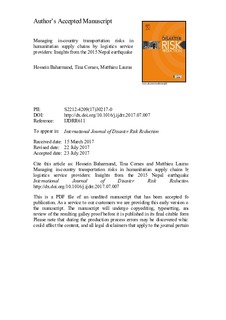| dc.contributor.author | Baharmand, Hossein | |
| dc.contributor.author | Comes, Tina | |
| dc.contributor.author | Lauras, Matthieu | |
| dc.date.accessioned | 2018-02-01T13:28:07Z | |
| dc.date.available | 2018-02-01T13:28:07Z | |
| dc.date.created | 2018-01-09T10:44:23Z | |
| dc.date.issued | 2017 | |
| dc.identifier.citation | International Journal of Disaster Risk Reduction. 2017, 24 549-559. | nb_NO |
| dc.identifier.issn | 2212-4209 | |
| dc.identifier.uri | http://hdl.handle.net/11250/2481239 | |
| dc.description.abstract | Humanitarian supply chains (HSCs) play a central role in effective and efficient disaster relief operations. Transportation has a critical share in HSCs and managing its risks helps to avoid further disruptions in relief operations. However, there is no common approach to or culture of risk management that its applicability has been studied through recent cases. This paper incorporates an empirical research design and makes a threefold contribution: first, it identifies in-country transportation risks during Nepal response. Second, we evaluate afore identified risks through an expert driven risk assessment grid. Third, we use our field data to study how some humanitarian organizations in Nepal response used logistics service providers for managing moderate- and high-level transportation risks. In this paper, we use both qualitative and quantitative methods. Our qualitative analysis reveals that some of the most important in-country transportation risks were delivery delays; market fluctuations; insufficient capacity; loss of cargo; cargo decay; unreliable information; and ethical concerns. Our quantitative work shows that while participants categorized the first three risks as high-level, the rest were ranked as moderate-level. More investigation in our field data indicates that using logistics service providers (LSPs) helped humanitarians significantly to manage afore in-country transportation risks during Nepal response. It also improved overall HSC performance with respect to flexibility, effectiveness, efficiency, and responsiveness. While this finding empirically confirms the “tools” role of LSPs for managing in-country transportation risks in response, it implies another role for LSPs; “contributors” to performance improvements. | nb_NO |
| dc.language.iso | eng | nb_NO |
| dc.title | Managing in-country transportation risks in humanitarian supply chains by logistics service providers: Insights from the 2015 Nepal earthquake | nb_NO |
| dc.type | Journal article | nb_NO |
| dc.type | Peer reviewed | nb_NO |
| dc.description.version | acceptedVersion | nb_NO |
| dc.source.pagenumber | 549-559 | nb_NO |
| dc.source.volume | 24 | nb_NO |
| dc.source.journal | International Journal of Disaster Risk Reduction | nb_NO |
| dc.identifier.doi | http://dx.doi.org/10.1016/j.ijdrr.2017.07.007 | |
| dc.identifier.cristin | 1538557 | |
| dc.relation.project | Universitetet i Agder: 464989 | nb_NO |
| dc.description.localcode | nivå1 | nb_NO |
| cristin.unitcode | 201,15,4,0 | |
| cristin.unitname | Institutt for informasjons- og kommunikasjonsteknologi | |
| cristin.ispublished | true | |
| cristin.fulltext | preprint | |
| cristin.qualitycode | 1 | |
